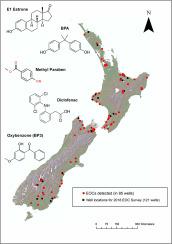Science of the Total Environment ( IF 9.8 ) Pub Date : 2020-09-04 , DOI: 10.1016/j.scitotenv.2020.142005 Murray E. Close , Bronwyn Humphries , Grant Northcott

|
The first national survey of Emerging Organic Contaminants (EOCs) involved sampling 121 wells located throughout New Zealand and analysis for a suite of 29 EOCs. This survey was carried out in conjunction with the 2018 national survey of pesticides in groundwater, a survey that is conducted on a four-yearly basis which included the analysis of glyphosate for first time. A total of 227 EOCs were detected in the 85 wells (70%). There were 29 different EOCs in the analytical suite and 25 different EOCs were detected in at least one well. The highest concentration measured was 655 ng/L for sucralose, an artificial sweetener. These results indicate that EOCs, sourced from either animal or human effluents/activities, are making their way into shallow groundwater systems and can be detected at low concentrations. A total of 135 wells were analysed for glyphosate, glufosinate and their principal metabolites. There was only one detection of glyphosate at a concentration of 2.1 μg/L. This well showed evidence of poor wellhead protection and the contamination likely came from containers that were stored near the well. A total of 279 wells were sampled and analysed for pesticides and 68 wells (24.4%) contained detectable residues of pesticides, with 28 of these wells having two or more pesticides detected. The maximum number of pesticides detected in one well was six. None of the sampled wells exceeded the Maximum Acceptable Value (MAV) for drinking water in New Zealand and the concentrations of most of the detected pesticides were equivalent to less than 0.5% of the MAV. Comparisons with earlier National Surveys of pesticides in groundwater in New Zealand indicate the frequencies of pesticide detections have remained similar over the last 16 years, with higher detection frequencies occurring before that time.
中文翻译:

2018年首次对新西兰地下水中的农药和新兴有机污染物(EOC)进行全国联合调查的结果
第一次全国性的新兴有机污染物(EOC)调查涉及对整个新西兰的121口井进行采样并分析了29种EOC。该调查与2018年全国地下水中农药调查一起进行,该调查每四年进行一次,其中首次包括草甘膦的分析。在85口井中总共检测到227个EOC(70%)。分析套件中有29种不同的EOC,并且在至少一口井中检测到25种不同的EOC。三氯蔗糖(一种人造甜味剂)的最高测量浓度为655 ng / L。这些结果表明,源自动物或人类污水/活动的EOC正在进入浅层地下水系统,并且可以低浓度检测到。总共分析了135个孔的草甘膦,草铵膦及其主要代谢产物。仅检测到浓度为2.1μg/ L的草甘膦。该井显示出井口保护效果不佳的证据,并且污染很可能来自井附近存储的容器。总共对279口井进行了采样并分析了农药,其中68口井(占24.4%)含有可检测到的农药残留,其中28口井中检测到两种或多种农药。一口井中检出的农药最多为六种。在新西兰,没有任何采样井的饮用水超过最大可接受值(MAV),而且大多数检测到的农药的浓度均不到其MAV的0.5%。



























 京公网安备 11010802027423号
京公网安备 11010802027423号